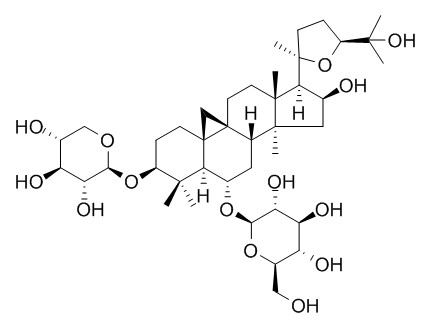Natural Products
Astragaloside IV
| Catalog No. | CFN99171 |  |
| CAS No. | 84687-43-4 | |
| Molecular Weight: | 784.98 | |
| Molecular Formula | C41H68O14 | |
| DBs | [PubChem]:274951247 [ChEMBL]:65457 [PCIDB]:35248 |
Standard InChI:
InChI=1S/C41H68O14/c1-35(2)24(54-33-29(48)26(45)20(44)17-51-33)9-11-41-18-40(41)13-12-37(5)31(39(7)10-8-25(55-39)36(3,4)50)19(43)15-38(37,6)23(40)14-21(32(35)41)52-34-30(49)28(47)27(46)22(16-42)53-34/h19-34,42-50H,8-18H2,1-7H3/t19-,20+,21-,22+,23-,24-,25-,26-,27+,28-,29+,30+,31-,32-,33-,34+,37+,38-,39+,40-,41+/m0/s1
Biological Activity
Astragaloside IV, a saponin isolated from Astragalus membranaceus, has been shown to protect the myocardium against ischemia/reperfusion injury, it also has beneficial effect in H/R-induced injury may be related to normalization of SR Ca2+ pump expression and, thus, it may prevent the depression in SR Ca2+ handling.[1]
Astragaloside IV synergizes with ferulic acid to inhibit renal tubulointerstitial fibrosis in rats with obstructive nephropathy.[2]
Astragaloside IV attenuates glycated albumin-induced epithelial-to-mesenchymal transition by inhibiting oxidative stress in renal proximal tubular cells.[3]
Astragaloside IV can reduce phosphorylation of JNK and ERK1/2 induced by complement membranous attack complex, the mechanism of Astragalus membranaceus in the treatment of membranous nephropathy (MN) may be related to its attenuation of podocyte injury through regulation of cytoskeleton and mitogen activated protein kinase. [4]
Astragaloside IV can reduce blood pressure and triglyceride levels in fructose-fed rats and high dose of astragaloside IV also improves glucose tolerance and endothelium-dependent vasorelaxation, the mechanism is associated with increased levels of aortic NOx and cGMP and is abrogated by blockade of nitric oxide synthase with NG-nitro-l-arginine methyl ester (l-NAME), suggests that astragaloside IV may be useful in ameliorating food-induced metabolic syndrome.[5]
Astragaloside IV attenuates inflammatory cytokines by inhibiting TLR4/NF-кB signaling pathway in isoproterenol-induced myocardial hypertrophy, and attenuates Toll-like receptor 4 expression via NF-κB pathway under high glucose condition in mesenchymal stem cells.[6,7]
Astragaloside IV can inhibit adenovirus replication and apoptosis in A549 cells in vitro.[8]
Astragaloside IV can inhibit doxorubicin-induced cardiomyocyte apoptosis mediated by mitochondrial apoptotic pathway via activating the PI3K/Akt pathway.[9]
Product
Official website: Astragaloside IV
Japanese website: Astragaloside IV
Chinese website: Astragaloside IV
Japanese website: Astragaloside IV
Chinese website: Astragaloside IV
References
[1] Xu X L, Chen X J, Ji H, et al. Pharmacology, 2008, 81(4):325-32.
[2] Meng L, Tang J, Wang Y, et al. Brit J Pharmacol, 2011, 162(8):1805-18.
[3] Qi W, Niu J, Qin Q, et al. Cell Stress & Chaperon, 2014, 19(1):105-14.
[4] Rong Z, Deng Y, Chen Y, et al. Phytother Res, 2012, 26(6):892-8.
[5] Zhang N, Wang X H, Mao S L. Molecules, 2011, 16(5):3896-907.
[6] Yang J, Wang H X, Zhang Y J, et al. J Ethnopharmacol, 2013, 150(3):1062–70.
[7] Li M, Yu L, She T, et al. Eur J Pharmacol, 2012, 696(1-3):203-9.
[8] Shang L, Qu Z, Sun L, et al. J Pharm Pharmacol, 2011, 63(5):688-94.
[9] Jia Y, Zuo D, Li Z, et al. Chem Pharm Bull, 2014, 62(1):45-53.
[10] Liu Q, Zhongdong L I, Liu J, et al. Chinese Journal of Modern Applied Pharmacy, 2010(04):355-8.
Product Use Citation





